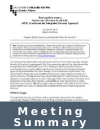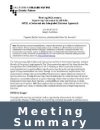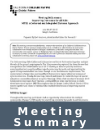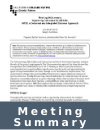The California Collaborative on District Reform periodically releases letters, briefs, reports, and policy statements to document the work of California districts and to inform discussion around relevant policy issues. Please visit the following links to see California Collaborative research briefs, policy statements, and meeting summaries:
Publications
Keeping the Main Thing the Main Thing: Lessons About Effective School Board Governance From Napa Valley and San José Unified School Districts
February 2024
The many pressures facing school districts – academic and social-emotional recovery from the pandemic, educator shortages, fragmented funding streams and programs, and more – can easily overwhelm educators and distract from the core work of instruction and student learning. Locally elected school boards, the governing bodies responsible for setting district policy, can play an instrumental role in establishing and maintaining focus in a school district’s work. As a counterpoint to the increasingly common media reports on school boards that highlight dysfunction and disruption, this report Keeping the Main Thing the Main Thing: Lessons About Effective School Board Governance From Napa Valley and San José Unified School Districts profiles two California school districts that have collaborative and productive approaches to governance. The practices and lessons learned from NVUSD and SJUSD can help governance teams across the country work together to establish and maintain focus on their highest priorities.
A companion piece, Keeping the Main Thing the Main Thing: Reflections from the Field, features insights from four California Collaborative members about the report and the lessons it identifies. These leaders in K-12 education lend their perspectives from careers in research, practice, and advocacy to help situate lessons from the report in the context of their work.
Register for a webinar featuring members of the governing teams in NVUSD and SJUSD on Thursday, March 7, 2024.
Making it Matter: A Systems Approach to Advancing Equity and Excellence for Students
April 2023
When California released its most recent Smarter Balanced standardized test results in October 2022, the picture was not pretty: only 47% of students met state standards in English language arts, while a mere 33% performed at standard in math. Declines in test scores were widespread across all student groups. More troubling, disparities among racial and ethnic groups and English learners, which had existed prior to the pandemic, had widened, adding new evidence that the pandemic had impacted certain student groups more acutely than others. In light of these outcomes, the stakes are incredibly high in California to provide access to a high-quality education in a safe environment for all students. Reverting to business as usual will not work because the system was not working for historically neglected populations—students with disabilities, students from low-income households, foster youth, homeless youth, undocumented students, indigenous students, Black and Brown students, and students who identify as LGBTQ—prior to the pandemic.
As districts across the state resumed full-time instruction and began the task of pandemic recovery, members of the California Collaborative on District Reform convened three times in 2021–22 to continue and deepen their ongoing exploration of local strategies for meeting students’ academic, social and emotional, and mental health needs. Of particular concern in these gatherings was the need to address systemic contributors to the persistent inequities in both educational opportunities and outcomes that the pandemic had accentuated.
This brief summarizes key takeaways from discussions among meeting participants exploring ways in which school systems center equity in their work. Importantly, the districts sharing their work and strategies in these meetings vary significantly in the human capital and other resources available to them, and each is at a different place in its equity journey. Nevertheless, the core takeaway was clear: centering equity begins with an explicit and visible commitment on the part of district leaders. But words alone are not enough. Participants in these meetings stressed that this commitment must become systemic action and must be integrated into all aspects of a district’s work. This was both the message and the goal of the district leaders participating in these Collaborative convenings.
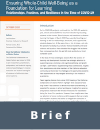
A Case for Coherence: Fulfilling California's Community Schools Promise
June 2022
With students, families, and the education systems that serve them still reeling from the effects of the COVID-19 pandemic, a $3 billion state investment in community schools offers an opportunity for system transformation that can address urgent and persistent whole-child needs and their impact on teaching and learning. Although the possibilities for progress are enormous, so are the prospects for unintended consequences of well-meaning—yet superficial and fragmented—school improvement efforts. A new brief from the California Collaborative on District Reform, A Case for Coherence: Fulfilling California’s Community Schools Promise, outlines considerations for ensuring that California’s community schools push achieves its potential. If districts can recognize and build on their existing strengths, foster coherence across district improvement efforts by centering them on a clear vision, develop plans to sustain their efforts across time, and maintain a laser focus on improving opportunities and outcomes for youth, the opportunity for true system transformation could bear fruit for the youth who need it most.
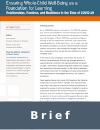
Educational Leadership in Crisis: Reflections from a Pandemic
January 2022
In the nearly 2 years since the SARS-CoV-2 virus burst on the American scene, more than 850,000 Americans have died, and elections have literally been won or lost on public officials’ positions and actions in response to COVID-19. Nowhere have the tensions and leadership demands been more visible than in the school systems that serve elementary and secondary school children, their parents, and communities. Educational Leadership in Crisis: Reflections From a Pandemic, explores how some California district leaders have responded to the initial and continuing COVID-19 crisis, using the reflections of superintendents in the California Collaborative on District Reform to reveal patterns, themes, and lessons. The brief also considers the impact that the pandemic and school closures have had on the leaders themselves and the implications of that impact for the future. The authors conclude by applying the principles of high reliability organizations to suggest how local districts and their leaders might capitalize on the work to date, not only to navigate the continuing challenges of the current pandemic and recovery but also to prepare for the inevitable crises of the future.
For other resources from the California Collaborative related to the COVID-19 pandemic, please see https://cacollaborative.org/topics/covid-19
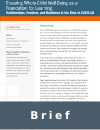
Reflecting Back and Looking Forward: Educational Equity in the Era of COVID-19
April 2021
A year after school closures and transitions to remote instruction, early evidence suggests that the negative effects of the pandemic on student learning have been greatest among our most vulnerable student populations. Although districts were quick to provide meals and devices that addressed students’ basic needs, disparities in opportunities to learn have persisted, and in many cases widened. To understand how districts have responded to educational inequities during the pandemic, the California Collaborative on District Reform’s latest brief, Reflecting Back and Looking Forward: Educational Equity in the Era of COVID-19, describes three responses to educational challenges: providing access to safe and supportive learning environments, social-emotional supports, and high-quality instruction. These examples help to elevate lessons that may inform other districts as they seek to address disparities now and into the future.
For other resources from the California Collaborative related to the COVID-19 pandemic, please see https://cacollaborative.org/topics/covid-19
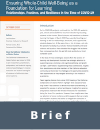
Ensuring Whole-Child Well-Being as a Foundation for Learning
October 2020
A trio of crises—the COVID-19 pandemic, resulting financial instability, and racial injustice—has disrupted learning environments and the relationships, structures, and supports that students depend on to thrive. The consequences are far-reaching, but they have been felt most acutely by our most vulnerable youth. In the face of these challenges, lessons from the science of learning and development illustrate how strategic attention to supporting social, emotional, and cognitive well-being can light a path forward. A new brief from the California Collaborative on District Reform, Ensuring Whole-Child Well-Being as a Foundation for Learning: Relationships, Routines, and Resilience in the Time of COVID-19, explores the ways in which the pandemic has introduced and exacerbated threats to whole-child health and well-being, but also draws attention to human resilience and the supports that can empower students and adults to navigate the obstacles in their way. It draws attention to relationships, routines, and resilience—“The New Three Rs”—as vehicles for supporting well-being and learning, and highlights emerging district practices that can foster resilience among all members of our school communities in this moment and beyond.
This brief shares insights from the California Collaborative on District Reform’s recent meeting on approaches to school re-entry during the COVID-19 pandemic. For more resources related to COVID-19, please visit https://cacollaborative.org/topics/covid-19.
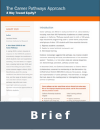
The Career Pathways Approach: A Way Toward Equity?
August 2020
In 2019, career pathways were offered in one-third of U.S. school districts, including more than 500 in California. A new brief from the California Collaborative on District Reform, The Career Pathways Approach: A Way Towards Equity?, examines the equity promise and challenge of pathways. At a time when traditional school experiences have been upended, students may struggle even more than normal to understand the relevance of their schoolwork and to connect it to opportunities after high school. Pathways can offer opportunities to enhance engagement, develop social capital, and build 21st century skills, especially for the most vulnerable students. To help pathways designers and implements fulfill the potential of the pathways approach, this brief offers conditions for equitable implementation and parallel strategies for success.
This brief shares insights from the California Collaborative on District Reform’s meeting in December 2019 on improving outcomes for all students using career pathways. For more information on this topic, please view the resources on the Meeting 40 page of the California Collaborative website.
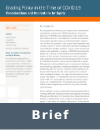
A Multi-Tiered System of Supports in Sanger Unified School District
June 2020
The COVID-19 pandemic has highlighted, and in many cases exacerbated, disparities among students that result from their socioeconomic status, language background, race and ethnicity, and disability classification. Now more than ever, school systems need to understand student needs and respond with targeted supports that address these needs. One model promoted by the California Department of Education and embraced by many districts around the state for serving all students well is a multi-tiered system of supports (MTSS). Given the varying conditions districts face during this time, and the range of student needs now and when schools reopen, a model of effective MTSS implementation might be particularly relevant and valuable as educators assess where students are and differentiate instruction to meet student needs based on those data. A new brief from the California Collaborative on District Reform, One System for All: A Multi-Tiered System of Supports in Sanger Unified School District, shares insights on one district’s experiences and lessons learned from implementing MTSS to improve learning for all California students.
This brief shares insights from the California Collaborative on District Reform’s meeting in 2018 on improving outcomes for all students by using a coherent and integrated MTSS approach. For more information on this topic, please view the resources on the Meeting 36 page of the California Collaborative website.
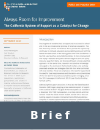
Leveraging Data for a Culture of Improvement: Priorities for District Leaders
June 2020
School closures in response to the COVID-19 pandemic have dramatically changed the conditions in which students learn and experience schooling. Disparities in students’ access to learning and in their academic outcomes are likely to exacerbate longstanding challenges and inequities. Now more than ever, educators need information that will help them address student needs, support improvement, and address these inequities. This brief draws on the experiences and lessons of local districts who have taken up the charge to improve access, use, and communication of data throughout their systems. The brief also shares insights for using data in the spirit of continuous improvement and in the service of all California students.

Grading Policy in the Time of COVID-19: Considerations and Implications for Equity
April 2020
The COVID-19 pandemic creates unprecedented conditions for K-12 teaching and learning, and education leaders everywhere are working quickly to make the best policy decisions possible. Knowing that the current context is dramatically different than previous school years and that students’ access to learning from home varies, how should schools grade student performance? This brief from the California Collaborative on District Reform, Grading Policy in the Time of COVID-19: Considerations and Implications for Equity, explores some of the policy options California districts and other states have pursued, as well as considerations and tradeoffs related to equity. The pandemic serves as a reminder that achieving equity for all students has always been a challenge; differential access to learning threatens to exacerbate existing disparities among students, schools, and districts. But it also raises the question: What can we do to shift this current circumstance to transform a broken, inequitable system to one that provides a high quality education for all?

Leveraging LCFF For Equity and Coherence: The Case of San José Unified School District
June 2019
California’s transition to a new governor, superintendent of public instruction, legislators, and members of the state board of education is an opportunity to reflect on the implementation of the Local Control Funding Formula (LCFF). Namely, has the school finance system achieved its original goals of promoting local control, equity, and greater coherence in school districts? Some policy discussions about improving LCFF—including those on the campaign trail—have centered on increasing transparency requirements to understand how districts are achieving these goals, but those conversations too often treat transparency as an end in itself. A new brief from the California Collaborative on District Reform shines a spotlight on San José Unified School District (SJUSD), where implementing the new state policy helped the district maintain high levels of coherence, honor the priorities of their community, and promote equitable resource allocation. This brief asks new state leaders working to refine LCFF to consider examples like SJUSD, where key priorities of the policy–and not compliance–are the guiding principles behind all the district’s actions.
For more information about improvement efforts in SJUSD, please see resources from Meeting 20 and Meeting 30, as well as the Collaborative’s report on the partnership between the district and teachers union in San Jose.

Brief Shares Recommendations from the LCFF Test Kitchen
April 2019
Governor Newsom’s January budget proposal outlines plans for a single web-based application that can merge various district reporting tools to increase efficiency and public understanding. Drawing on the experiences of the LCFF Test Kitchen, a new brief offers four recommendations for making the most of this proposal: (1) Articulate the goals and desired outcomes of a single web-based reporting platform to align reporting structures. (2) Engage end users throughout the development process. (3) Foster competition to generate an innovative, single web-based reporting platform design. (4) Create structures and supports to build trust between school districts and their communities. Through a process that values end users and fosters innovation, we can both support and improve upon the Governor’s proposal, thereby helping to create the conditions for continued progress in our schools and communities. For more information about the LCFF Test Kitchen, please visit https://lcfftestkitchen.org/.
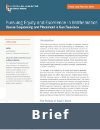
Brief Describes Math Course Sequencing and Placement in San Francisco
March 2019
In the face of stagnant achievement and persistent achievement gaps in mathematics, school districts have enacted a variety of changes to varying levels of success. On the heels of an Algebra for All model that failed to generate desired outcomes of students, San Francisco Unified School District adopted a policy in 2014 that dramatically changed its sequence of mathematics courses. The district completely de-tracked its middle school classes, enrolling all students in the same heterogeneously grouped courses for Grades 6, 7, and 8. San Francisco’s policy represents a significant departure from traditional approaches to organizing mathematics courses, and early outcomes appear to validate this approach. This brief describes the rationale behind the district’s decision, the nature of the new policy, and the promising results the district has experienced so far.
This brief shares information from the California Collaborative’s December 2018 meeting on understanding and addressing challenges in mathematics instruction and student learning. For more information on this topic, please view the resources on the Meeting 37 page of the California Collaborative website.
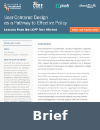
User-Centered Design as a Pathway to Effective Policy: Lessons Learned from the LCFF Test Kitchen
February 2019
This is the second of two briefs coming out of the LCFF Test Kitchen. This brief addresses a broader question underlying the LCFF Test Kitchen: to what extent can user-centered design help us address policy challenges? It identifies lessons learned over the Test Kitchen’s first year and implications for a different approach to education policy. The first brief can be found here.
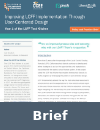
Improving LCFF Implementation Through User-Centered Design: Year 1 of the LCFF Test Kitchen
February 2019
The LCFF Test Kitchen has enabled three school districts to make progress by leveraging the power of user-centered design. This is the first of two briefs coming out of the LCFF Test Kitchen Work and describes the districts' progress in Year 1 of the Test Kitchen and the solutions it has generated. The second of the two briefs can be found here.
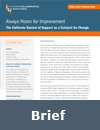
Always Room for Improvement: The California System of Support as a Catalyst for Change
September 2018
In the 2017-18 school year, the California State Board of Education rolled out a new statewide system of support for local education agencies, with the goal of moving away from punitive accountability policies toward working alongside schools and districts to respond directly to local needs and contexts. Distilling lessons from prior research, practice, and continuous improvement endeavors, this brief outlines key principles of effective support and presents state policymakers, county offices, districts, and support providers with suggestions on how to engage in this work productively to ensure that the sytem successfully serves the students of California.
This brief was developed in response to the California Collaborative on District Reform's December 2017 meeting on the development of the new system of support. For more information on this topic, please view the resources on the Meeting 34 page of the California Collaborative website.
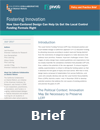
Fostering Innovation: How User-Centered Design Can Help Us Get the Local Control Funding Formula Right
July 2017
The Local Control Funding Formula (LCFF) has introduced positive and much-needed change to California’s approach to K-12 education funding by allocating resources according to student need and freeing districts to make decisions that address local priorities. For all of LCFF’s advantages, however, the Local Control Accountability Plans (LCAPs) in which districts articulate their programmatic and spending decisions have received criticism for being archaic, cumbersome, difficult to complete, opaque, and incoherent. This brief, written in partnership with Pivot Learning, is the fifth in a series from the California Collaborative exploring key issues of LCFF implementation, and it describes an alternative approach to solving policy problems. The brief shares four prototypes that emerged from a November 2016 design sprint as new approaches to achieving LCFF goals. By embracing user-centered design, California’s education leaders have an opportunity to overcome flaws in the LCAP, fulfill the potential of LCFF, and preserve the funding system through the upcoming statewide elections and into the future.
For more information about LCFF, please view the resources on the Meeting 29 and LCFF pages of the California Collaborative website.
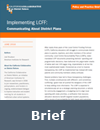
Implementing LCFF: Communicating About District Plans
July 2016
As they continue to implement the Local Control Funding Formula (LCFF), California educators find themselves struggling to communicate district plans to parents, teachers, and other members of the school community. To help inform the community about districts’ plans and results, many districts voluntarily produced supplementary materials to accompany their 2015 Local Control Accountability Plan (LCAP). Following suit, the State Board of Education is considering “executive summaries” as one solution to effectively inform the public. But what does a good executive summary or other outreach approach look like? This brief, the fourth in a series from the California Collaborative exploring key issues of LCFF implementation, identifies some guidelines for district leaders to make their plans more accessible.
For more information about LCFF, please view the resources on the Meeting 29 and LCFF pages of the California Collaborative website.
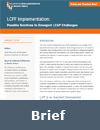
Implementing LCFF: Possible Solutions to Emergent LCAP Challenges
January 2016
The Local Control Accountability Plan (LCAP), a state-required document in which districts describe their goals, their strategies to achieve these goals, and the resources allocated to support these strategies, is a central component of California’s Local Control Funding Formula (LCFF). Having completed two rounds LCAP submissions, district leaders and others around the state have learned much about what the process entails, where it has created the conditions for improved practices and outcomes, and where obstacles remain. This brief, the third in a series from the California Collaborative exploring key issues of LCFF implementation, outlines the key challenges undercutting the LCAP’s effectiveness and offers short term and long term solutions to these identified challenges.
For more information about LCFF, please view the resources on the Meeting 29 and LCFF page of the California Collaborative website.
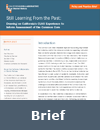
Learning from the Past: Drawing on California’s CLAS Experience to Inform Assessment of the Common Core
March 2015
As California approaches a new system of academic standards, instruction, and assessment, it enters familiar territory. The use of multiple modes of assessment, tight alignment between assessments and expectations for student learning, and a focus on assessment for formative (as well as summative) purposes—all with an emphasis on students’ understanding and ability to apply their learning—mirror the state’s priorities as it transitioned to the California Learning Assessment System (CLAS) in the early 1990s. These policy and practice briefs examine the CLAS experience to identify lessons for districts as they implement the Common Core today. Through these lessons, districts across the state might build on promising practices from two decades ago while avoiding some of the pitfalls that undermined the CLAS effort. These briefs were an outcome of the California Collaborative meeting Digging Into the Standards: Assessment and the Common Core.
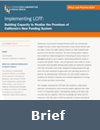
Implementing LCFF: Building Capacity to Realize the Promises of California’s New Funding System
November 2014
California’s Local Control Funding Formula (LCFF) has introduced changes that alter the conditions under which educators, administrators, and community leaders approach their roles in the K-12 education system. Consequently, leaders at all levels may need to build the capacity—both the knowledge and skills and the resources—that they need to fulfill the potential of the new funding formula. This brief, the second in a series from the California Collaborative exploring LCFF implementation issues, highlights some of those capacity needs. Recognizing and addressing the demands for improved capacity at all levels of the system will be essential for achieving success with the new funding system.
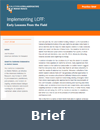
Implementing LCFF: Early Lessons From the Field
July 2014
The Local Control Funding Formula (LCFF) represents a fundamental transformation of the way California allocates state funds to school districts and the ways the state expects districts to make decisions about (and report on) the use of these funds. This brief identifies some early lessons about how best to use the new system to meet student needs, especially the traditionally underserved. It highlights key areas that merit attention from California education stakeholders, as well as issues of communication around priorities and expectations that can help support the successful enactment of the new funding policy.
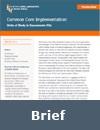
Common Core Implementation: Units of Study in Sacramento City
March 2014
As district leaders search for the best ways to improve student learning with the Common Core State Standards, some early implementers are giving us an opportunity to learn from their experience. This brief describes Sacramento City Unified School District’s approach to developing units of study that guide teachers’ classroom practice. The units provide a valuable tool for designing curriculum and instructional materials, but just as importantly, they have driven teacher capacity building and engagement teachers in the implementation of the new standards. The brief examines the units of study strategy as it has unfolded in Sacramento, identifies some of the key points of evolution since the district began its work three years ago, and discusses some of the challenges and tensions facing districts that might employ a similar approach.
For more information about SCUSD and Common Core implementation, please view the resources on the Meeting 23 and Common Core pages of the California Collaborative website.
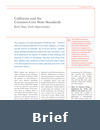
California and the Common Core State Standards: Early Steps, Early Opportunities
February 2013
This brief stems from the symposium Collaborating for Success: Implementing the Common Core State Standards in California co-hosted by the California Collaborative in August 2012. It provides an overview of the promises and challenges of implementing the Common Core State Standards (CCSS) as discussed at the symposium by several national experts. In particular, California Collaborative member, Kenji Hakuta, emphasized the importance of linking English language development with content. The report presents themes which emerged from conversations among district leaders about their strategies for and experiences with implementing the CCSS. Themes include strategies for communicating the CCSS vision to various audiences, aligning resources, tools, policies, and practices to support CCSS implementation, and building partnerships with community organizations such as afterschool providers. The report concludes with a discussion of next steps in California’s transition to the CCSS including the need to ensure equity and access for all students as well as navigating the statess upcoming transition to a new accountability system.
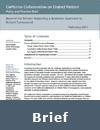
Beyond the School: Exploring a Systemic Approach to School Turnaround
February 2011
Recent attention to school turnaround often situates the causes for (and solutions to) persistent low performance at the school level. This policy and practice brief draws on the experience of eight California school districts to suggest a more systemic approach to school improvement. By looking at common approaches across all eight districts and by sharing three districts stories more in-depth, the brief demonstrates the ways that districts can leverage their capacity and resources to more effectively achieve growth in struggling schools. Based on this work, the brief concludes with a set of considerations for how the federal government can promote a more systemic and customized approach to intervention in our lowest-performing schools through the reauthorization of the Elementary and Secondary Education Act (ESEA).
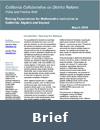
Raising Expectations for Mathematics Instruction in California: Algebra and Beyond
March 2010
This policy and practice brief builds on dialogue that began in response to the California State Board of Education’s July 2008 motion to make Algebra 1 the test of record for California’s eighth grade students. While this decision has since been overturned, districts need to continue to think of ways to help all students meet high standards in mathematics, recognizing the gateway that algebra provides to higher mathematics and college access. To this end, the brief discusses ways in which districts can approach the creation of strong K-12 mathematics curriculum, appropriate placement of students in mathematics courses, enhancement of instructional capacity, and provision of supports for struggling students given the current fiscal and political context in California. The brief concludes with a set of policy recommendations.

Policy Briefs on California Education Finance and Governance
October 2007
In October 2007, EdSource hosted a policy convening in response to findings from the Getting Down to Facts research project. These four briefs were prepared by a working group of district Collaborative members to inform the dialogue of this “Getting from Facts to Policy” conference. They advocate for new state policy in the areas of (1) governance and finance, (2) standards based funding and accountability systems, (3) accessible and informative data, and (4) teacher preparation and development.

Keeping the Main Thing the Main Thing: Lessons About Effective School Board Governance From Napa Valley and San José Unified School Districts
February 2024
The many pressures facing school districts – academic and social-emotional recovery from the pandemic, educator shortages, fragmented funding streams and programs, and more – can easily overwhelm educators and distract from the core work of instruction and student learning. Locally elected school boards, the governing bodies responsible for setting district policy, can play an instrumental role in establishing and maintaining focus in a school district’s work. As a counterpoint to the increasingly common media reports on school boards that highlight dysfunction and disruption, this report Keeping the Main Thing the Main Thing: Lessons About Effective School Board Governance From Napa Valley and San José Unified School Districts profiles two California school districts that have collaborative and productive approaches to governance. The practices and lessons learned from NVUSD and SJUSD can help governance teams across the country work together to establish and maintain focus on their highest priorities.
A companion piece, Keeping the Main Thing the Main Thing: Reflections from the Field, features insights from four California Collaborative members about the report and the lessons it identifies. These leaders in K-12 education lend their perspectives from careers in research, practice, and advocacy to help situate lessons from the report in the context of their work.
Recording of a webinar featuring members of the governing teams in NVUSD and SJUSD on Thursday, March 7, 2024.

From Combat to Collaboration: The Labor-Management Partnership in San José Unified School District
December 2017
It started with a cup of coffee. In the wake of an intense contract negotiation, and against the backdrop of a district bankruptcy, multiple teacher strikes, and a wave of mistrust that veterans of the era still refer to as "rock bottom," the San José superintendent and the San José Teachers Association president decided to chart a different path forward. A new report from the California Collaborative on District Reform, From Combat to Collaboration, explores the way in which the district and union laid the groundwork for a new way of working together, how leaders have continued to foster and deepen the partnership, the day-to-day policies and practices that allow the relationship to flourish, and how collaboration enables the district to better serve its students. The report concludes with a set of lessons that can inform other districts and unions seeking to develop a more productive relationship. For more information about San José Unified, please visit the Meeting 30 page.
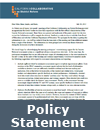
Letter to the CDE and SBE about Community Schools
January 2022
Community schools emphasize both the holistic and coordinated nature of improvement efforts that can make a difference for students. The California Community Schools Partnership program is an important and welcome investment from the state, but aspects of the current environment and traditional patterns of policymaking in the state could undercut the potential for achieving and sustaining coherent implementation at the local level. This letter from incoming and outgoing California Collaborative chairs Joel Knudson and Jennifer O’Day offers three considerations for finalizing the details of the community schools grants program to increase the likelihood of realizing its admirable goals.
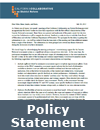
Collaborative Writes a Letter to SBE and CDE about Smarter Balanced Experiences
July 2015
The California Collaborative’s June 2015 meeting in Whittier Union High School District gave district leaders the opportunity to provide feedback on the first official administration of California’s new Smarter Balanced assessments in English language arts and mathematics. Overall, meeting participants expressed support for the new assessment system as a significant advance over previous state tests. At the same time, those present recognized that the state is in the early stages of a learning process and offered several suggestions to improve assessment administration and reporting. Meeting guest Ilene Straus, vice president of the State Board of Education (SBE), encouraged the California Collaborative to compile relevant feedback to share with the SBE and California Department of Education. This letter highlights some of the key points that emerged in the meeting conversation. For more details about the discussion, please view our Meeting Summary.

Collaborative Members Support Local Control Funding Formula
April 2013
Eight superintendents on the California Collaborative on District Reform, as well as the chair of the group, wrote a letter urging Joan Buchanan, the chair of the Assembly Education Committee, to pass the the Local Control Funding Formula (LCFF) in the budget this year. They argue that the current accountability system is undermined with over-regulation and cumbersome bureaucracy that impedes districts’ ability to develop coherent educational approaches. Under LCFF, all students would receive equal access to a base level of funding, with special attention paid to how we fund low-income students, English learners, and students in foster care. The letter argues that LCFF will create an education finance system with increased local flexibility and transparency so that district and school staff can focus directly on improving education outcomes and ensure that students drive the allocation of resources.
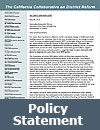
California Collaborative Urges State to Move Forward with a Thoughtful Weighted Pupil Formula Policy
May 2012
The California Collaborative on District Reform, led by 10 district leaders from across the state, issued a letter to the Governor urging the state to move forward with a weighted pupil formula (WPF) to improve our state’s ability to educate children to their fullest potential. Arguing that now is the time to make the long-standing collective cry for a dramatic change to California’s state funding system for education a reality, the Collaborative drew on member districts’ direct experience with navigating the allocation of funding to meet student needs to outline four key considerations for enacting a WPF in a way that translates to improved student learning opportunities—including the need for a continued focus on an adequate amount of funding for all districts regardless of the funding formula.
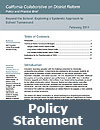
Beyond the School: Exploring a Systemic Approach to School Turnaround
February 2011
An exploration of eight California districts participating in the California Collaborative on District Reform highlighting the critical district role in supporting school improvement and student learning. The experiences of these districts—Fresno, Long Beach, Los Angeles, Oakland, Sacramento City, San Bernardino, San Jose, and Sanger Unified School Districts—reveal two equally central lessons for school turnaround.

The California Collaborative Encourages Adoption of the Common Core
June 2010
The California Collaborative on District Reform met as a group on June 29-30, 2010 to review the Common Core State Standards in depth, examine their relationship to California’s current standards, and discuss what their adoption would mean for student learning in the state. After previous study and this intensive two-day meeting, the group decided collectively to encourage the adoption of the Common Core State Standards through this letter to Governor Arnold Schwarzenegger. The California State Board of Education unanimously voted to adopt the Common Core State Standards on August 2.
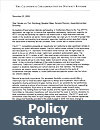
California Collaborative District Leaders Advocate for Flexibility Provisions in Race to the Top Legislation
December 2009
Seven California superintendents, including those from six California Collaborative districts, wrote this letter to California legislative leaders supporting the reinstitution of provisions for district flexibility in Race to the Top legislation. In exchange for clear eligibility and accountability criteria, districts would receive the same level of flexibility provided under current law to charter schools. Such flexibility can encourage innovation, support system learning, and give much needed fiscal and strategic support to students, teachers, and school districts and their families to support student learning. The letter was ultimately unsuccessful at changing the legislative language for Race to the Top. However, a bill currently under review by the California legislature (SB 1396) may achieve similar flexibility on a smaller scale.
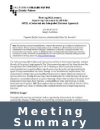
Meeting 52 Summary
April 2024
Body
In February 2024, members of the California Collaborative on District Reform convened in Oakland, California, for their second meeting of the 2023–24 academic year. Meeting participants continued attending to issues of coherence discussed in previous meetings, this time sharpening the focus on instruction using the lens of a literacy and language framework developed in Oakland Unified School District (OUSD). Because OUSD recognizes the importance of supporting students in acquiring language skills while concurrently developing their literacy skills, the discussions throughout the meeting emphasized the interconnected and mutually supportive strategies required to support both language and literacy.

Meeting 51 Summary
January 2024
Our meeting on October 31-November 1 in Elk Grove represented an important progression from recent emphases on the immediate challenges facing school districts as they navigate various stages of pandemic recovery, including attention to elevating whole-child well-being, advancing racial justice, and fostering coherence in the face of multiple competing priorities for educators' time and attention. During Meeting 51, participants deepened our attention to coherence by sharpening our focus on teaching and learning using the lens of an instructional framework in Elk Grove to explore approaches to cultivating educator commitment and improving teacher practice.

Meeting 50 Summary
June 2023
In May 2023, members of the California Collaborative on District Reform convened in Santa Ana, California, to continue a yearlong focus on systemic coherence in the face of continuing pressures and priorities that threaten to fragment and distract improvement efforts. Participants examined efforts to develop a graduate profile as an anchor for focusing district-level strategies to strengthen student learning. The convening was also an opportunity for Collaborative members and guests to step back and examine the evolving world for which schools need to prepare young people to thrive. The meeting enabled participants to explore ideas about the future of education and how school systems can best adapt to and prepare for changes in the learning environment and the broader world in which we live.

Meeting 49 Summary
April 2023
In February 2023, members of the California Collaborative on District Reform convened in San José, California, to continue an exploration of coherence across the state, board, central office, and school levels in service of instructional improvement. As school systems continue to grapple with pandemic-related educator burnout, integrate new state initiatives, and navigate pressures from community members to embrace particular priorities or adopt new programs, how can they maintain focus to best serve students? Collaborative members and meeting guests examined this question over two days across multiple levels of the TK-12 system, from local school boards to schools to the central office to the state.

Meeting 48 Summary
December 2022
In November 2022, members of the California Collaborative on District Reform convened in Sacramento, California, to dive into the topic of instructional improvement, with particular consideration of the role of site administrators and aligned professional learning in fostering cultures and practices that promote high-quality teaching and learning. To take advantage of the proximity to the state Capitol, meeting participants also engaged with several policy actors to discuss and explore the broader context and conditions that can enable districts—and the students they serve—to thrive. Across both sets of conversations, participants considered ways in which education systems at the state and local levels can foster coherence in school improvement efforts.

Meeting 47 Summary
August 2022
In June 2022, members of the California Collaborative on District Reform convened to continue their yearlong deep dive into matters of educational equity using the work conducted in Burbank Unified School District (USD) to ground their discussions. Picking up on a topic discussed in the previous Collaborative meeting in Long Beach, members and guests continued to explore the review and selection of instructional materials that foster inclusivity and engagement for all students. Conversation then turned to examine hate speech on school campuses and ways in which restorative practices can promote healing and understanding. The meeting concluded with a discussion on the role teachers can play in bringing a district’s equity commitments to life, and how professional development can serve as a critical vehicle for cultivating skills and mindsets.

Meeting 46 Summary
March 2022
In March 2022, members of the California Collaborative on District Reform convened in person for the first time in more than two years to deepen ongoing attention to matters of educational equity. Using the lens of the recently adopted Excellence and Equity Policy in Long Beach Unified School District (LBUSD), members and guests explored the district’s equity journey and considered strategies for embedding equity into efforts to engage students, develop and support principals, and select instructional materials that reflect and elevate student experiences and understanding.

Meeting 45 Summary
February 2022
In November 2021, members of the California Collaborative on District Reform convened virtually for the fifth time since the COVID-19 pandemic prompted the disruption of in-person learning in districts across the state. Meeting participants convened to discuss the challenges that district leaders, school administrators, and teachers face in ensuring that students’ social, emotional, and mental health needs are being addressed alongside academic needs in truly transformative ways. Grounding their discussions in the experiences of Garden Grove students who joined the group to share their experiences during the pandemic, members and guests explored ways in which a commitment to Transformative Social and Emotional Learning, a multi-tiered system of supports framework, and the principles of community schools can help districts serve the full range of student needs in a coherent way.
Resources from the meeting, including a summary of the group's conversation, are now available on the Meeting 45 page.

Meeting 44 Summary
October 2021
In June 2021, members of the California Collaborative on District Reform convened for the fourth time since the COVID-19 pandemic prompted the disruption of in-person learning in districts across the state. Although health concerns continue to evolve and shape district decisions, Collaborative members and guests met over two days in June to prepare for a return to in-person learning in the fall and the broader transition from crisis management to long-term recovery. Adopting language that Education Resource Strategies has used in its work with districts, participants incorporated teacher perspectives and student insights, explored strategic financial investments, and examined issues of measurement to consider what districts are building from, what they are doing now, and what they are building toward in their efforts to promote deep and lasting systemic improvement for students. Although the landscape of K-12 education in California has continued to evolve rapidly since the meeting took place, the lessons and insights nevertheless remain relevant for district action this summer, for fall 2021, and for the months and years ahead. Resources from the meeting, including a summary of the group’s conversation, are now available on the California Collaborative’s website at https://cacollaborative.org/meetings/meeting44.
For additional resources from the California Collaborative related to COVID-19, please visit https://cacollaborative.org/topics/covid-19.

Race, Equity, and COVID-19: Meeting 42 Summary
February 2021
